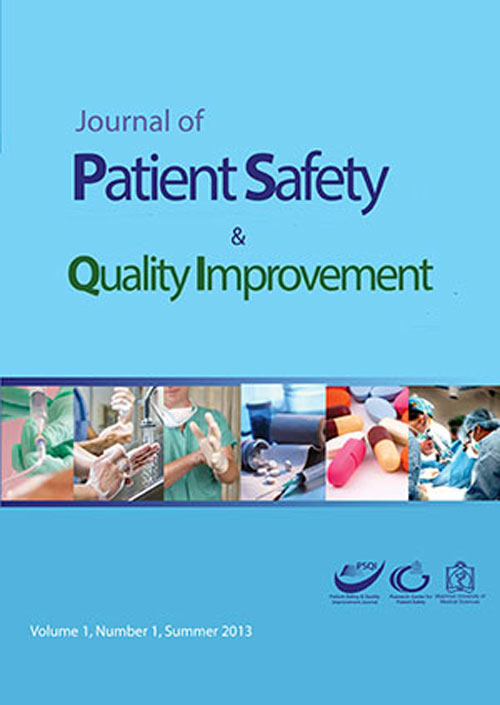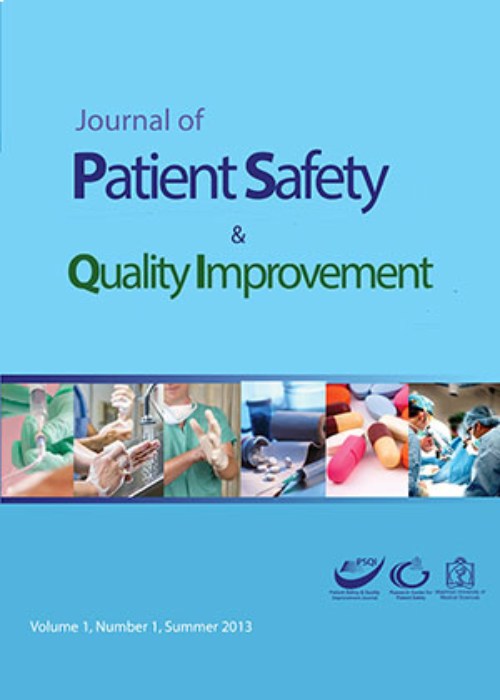فهرست مطالب

Journal Of Patient safety and quality improvement
Volume:4 Issue: 1, Winter 2016
- تاریخ انتشار: 1394/11/16
- تعداد عناوین: 8
-
Pages 308-312IntroductionHandover is the communication of clinical information to support the transfer of patient care and is a major contributing factor to patient safety. Handovers can be provided verbally or in a written format. This study aimed to determine the opinions regarding written handover and its importance, postulating that it has a critical role in ensuring patient safety and has justification for implementation where not present.Materials And MethodsAn observational online questionnaire comprising ten questions was sent to doctors at Luton and Dunstable University Hospital in September 2014. Answers to the questions were provided as free text or single row rating scale in a drop-down menu. The data were exported into SPSS to be analysed. Frequency and percentage of the answer choices were derived for each question.ResultsThe majority of respondents were physicians (51.3%). Those who had written handover stated that it was accurate with regards to patients’ clinical details (45%) and that inaccurate handover impedes quality of care and clinical management (61.7%). In cases where patient handover was not present, 28.3% of the respondents strongly agreed that handover could improve patient safety and staff familiarity with patients.ConclusionThe results suggest that written handover is a very powerful communication tool through which patient safety can be ensured, and its local and national implementation and maintenance are a possible logistical challenge. It is recommended to conduct further studies on this issue to determine its effectiveness once standardised and implemented within this study location, and at other care units.Keywords: Handover Patient Care Written
-
Pages 313-319IntroductionEvaluation of patient satisfaction is a common method used to determine the quality of medical services. This study aimed to assess the level of satisfaction in patients referring to the clinics of traditional Iranian medicine affiliated to Tehran University of Medical Sciences (TUMS), Iran.Materials And MethodsThis cross-sectional study was conducted on 260 patients with history of at least two referrals to the clinics of traditional medicine at TUMS. Subjects completed the Persian version of Patient Satisfaction Questionnaire (PSQ-18). Data analysis was performed using T-test, Chi-square, ANOVA and Pearson’s correlation coefficient.ResultsOut of 260 patients with the mean age of 41.01±12.95 years, 104 patients (63.1%) were satisfied, 9 (3.4%) were completely satisfied, 67 (25.8%) were dissatisfied with the medical services, and 20 patients (7.7%) were uncertain. In subscales of access to physician, time spent with doctor, interpersonal manner and overall satisfaction, number of satisfied patients was higher than their dissatisfied counterparts. However, rate of dissatisfaction was higher in subscales of technical quality, communication and financial aspects of care. Moreover, no statistically significant relationship was observed between satisfaction scores and age, gender, education status, type and duration of disease and marital status of the subjects.ConclusionAccording to the results of this study, over 60% of the patients were satisfied with the health care services offered at traditional medicine clinics. Insurance coverage for traditional treatments could significantly reduce treatment costs. Furthermore, technical quality and communication skills of practitioners need to be improved through training courses in the field of traditional medicine.Keywords: Health care Patient satisfaction Process assessment Traditional medicine
-
Pages 320-323IntroductionOsteoporosis is a common problem in postmenopausal women. Numerous studies investigated the effects of vitamin K on bone health, which yielded conflicting results. In this study, we aimed to compare the effect of vitamin K and alendronate combination with alendronate alone on Bone Mineral Density (BMD) of women with postmenopausal osteoporosis.Materials And MethodsThis study was performed in Imam Reza Hospital of Mashhad, Iran, during 14 months (January 1, 2014-February 29, 2015). Our patients (n=28) were randomly divided into two groups of receiving calcium, vitamin D, and alendronate (n=13) and receiving the same combination + vitamin K1 supplement (10 mg daily) (n=15). BMD was measured pre- and post-intervention by the same bone scanner.ResultsThe baseline characteristics of the two groups did not differ significantly. The mean variation in femoral neck BMD of the alendronate and alendronate + vitamin K groups were -4.20±11.91% and 0.39±11.80%, respectively. There was no significant difference between the two groups in terms of mean change in femoral neck BMD (P=0.32). The mean variations in lumbar spine BMD of the alendronate and alendronate + vitamin K groups were 0.71±0.06% and 0.76±0.11%, respectively. There was no significant difference between the two groups in terms of mean change in lumbar spine BMD (P=0.24).ConclusionIt was found that combined treatment with vitamin K and alendronate was not more effective than alendronate alone in increasing BMD of postmenopausal osteoporosis patients.Keywords: Alendronate Osteoporosis Vitamin K
-
Pages 324-326IntroductionAccording to statistics, opioid addiction is quite common in Iran. Pathologic dilatation of the Common Bile Duct (CBD) may be caused by mechanical obstruction or opioid consumption; the latter is especially common among chronic opium abusers. The aim of this study was to assess the relationship between CBD diameter and addiction-related factors in opium users.Materials And MethodsThis cross-sectional study was conducted in Imam Reza Hospital, Mashhad, Iran. A checklist, consisting of 18 items on demographic characteristics, type, administration route, and duration of opioid consumption, and type of biliary disease as indicated by Endoscopic Retrograde Cholangiopancreatography (ERCP), was prepared and completed via interview. The results of ERCP and abdominal ultrasonography of 40 addicted patients were gathered. Data were analyzed, using SPSS version 11.5. P-value less than 0.05 was considered statistically significant.ResultsIn total, 31 (62%) out of 50 patients were male, and the mean age of the subjects was 66±12.0 years. According to the findings, 46 (92%) cases were addicted to opium and four (8%) cases to laudanum (a solution prepared from opium). Among the addicted cases, 30 (75%) used opium through inhalation, while 10 (25%) cases used it orally. There was a significant relationship between the type of opioid and CBD diameter (P=0.03). However, no significant relationship was found between CBD diameter and the route of administration or opioid dose (P=0.6 and 0.06, respectively).ConclusionOpium used by addicts has various degrees of impurity. It can be concluded that higher opium purity induces more CBD dilatation, although further investigations are highly recommended.Keywords: Common bile duct diseases Endoscopic retrograde cholangiopancreatography Opioid related disorders Ultrasonography
-
Pages 327-333IntroductionNeonatal mortality is a global health issue. Preterm delivery is considered as a leading cause of neonatal mortality and morbidity. Preterm neonates may develop complications such as Respiratory Distress Symptom (RDS), Intraventricular Hemorrhage (IVH) and neonatal sepsis. This study aimed to evaluate the effective factors in the prognosis of preterm infants.Materials And MethodsThis cross-sectional study was conducted on 283 premature neonates born in Ghaem Hospital in Mashhad, Iran during September 2013-March 2014. Demographic data and perinatal mortality and morbidity rates were recorded for all the neonates. Data analysis was performed in SPSS Version19.ResultsIn this study, rates of morbidity and mortality were 33.2% and 18.7%, respectively. In total, 50.9% of the neonates were admitted to the neonatal intensive care unit. Among the study samples, 26.5% had RDS, 18.4% had neonatal sepsis, and 2.8% had IVH. Moreover, 18.4% of the neonates required mechanical ventilation. Increased gestational age and birth weight significantly reduced the rates of morbidity and mortality. Although mode of delivery and premature rupture of membranes affected the mortality rate, they had no significant associations with the morbidity rate of the neonates. Also, maternal factors such as age, gravidity, history of diseases or pregnancy complications, and drug use during pregnancy had no significant effects on the rates of neonatal morbidity and mortality.ConclusionAccording to the results of this study, gestational age and birth weight were the most significant predictive factors for neonatal morbidity and mortality in preterm infants.Keywords: Neonatal mortality Pregnancy complications Premature infant Preterm labor
-
Pages 334-339IntroductionThe aim of this study was to assess the status of patient safety in three hospitals, affiliated to Tehran University of Medical Sciences, based on the critical standards of Patient Safety Friendly Hospital Initiative (PSFHI).Materials And MethodsIn this cross-sectional study, conducted in 2014, we used PSFHI assessment tool to evaluate the status of patient safety in three hospitals, affiliated to Tehran University of Medical Sciences; these general referral hospitals were selected purposefully. PSFHI assessment tool is comprised of 140 patient safety standards in five domains, categorized in 24 sub-domains. The five major domains include leadership and management, patient and public involvement, safe evidence-based clinical practices, safe environment, and lifelong learning.ResultsAll three hospitals met more than 70% of the critical standards. The highest score in critical standards (> 80%) was related to the domain of leadership and management in all hospitals. The average score in the domain of safe evidence-based clinical practices was 70% in the studied hospitals. Finally, all the hospitals met 50% of the critical standards in the domains of patient and public involvement and safe environment.ConclusionBased on the findings, PSFHI is a suitable program for meeting patient safety goals. The selected hospitals in this survey all had a high managerial commitment to patient safety; therefore, they could obtain high scores on critical standards.Keywords: Hospital Patient Safety Patent Safety Friendly Hospital
-
Pages 340-343The main predictors of Heart Failure with preserved Ejection Fraction (HFpEF) are increased systolic blood pressure, atrial fibrillation, and female gender. Heart Failure (HF) with reduced Ejection Fraction (EF) is associated with prior myocardial infarction and left bundle-branch block QRS morphology. This study aimed to evaluate the effect of diastolic echocardiographic findings on the outcome of patients with HFpEF. This systematic review was conducted via searching in databases such as Cochrane Library and MEDLINE until September 2015, and articles with available abstracts published in English were included in the study. Manual search was performed within the reference lists of the articles. Moreover, two reviewers independently assessed the inclusion criteria, quality and extracted data of the selected articles. In total, four articles were evaluated in this systematic review, with the earliest study published in 2007 and the most recent article published in 2015. According to the results of this review, Doppler echocardiography plays a pivotal role in the assessment of diastolic left ventricular filling dynamics. However, this technique is restricted by the confounding effects of the changes in the heart rate and loading conditions.Keywords: Echocardiography Heart failure with preserved ejection fraction Patient
-
Pages 344-345IntroductionTo report a rare case of asymptomatic external ophthalmomyiasis manifesting with chronic corneal ulcer. Case: A 65-year-old diabetic female, residing in a rural area, was admitted to Khatam-al-Anbia Eye Hospital for diabetic retinopathy evaluation. The patient had no ocular surface complaints. On examination, her best-corrected visual acuity was counting fingers in the right eye and 4/20 in the left eye. A chronic corneal ulcer (similar to ocular herpes) was accidentally diagnosed in the superior cornea with three dead larvae in the superior tarsal conjunctiva. High-power magnified biomicroscopic examination did not indicate any intraocular infestation. Fundus examination revealed severe non-proliferative diabetic retinopathy and clinically significant macular edema in both eyes. After removing the dead larvae, the ulcer improved within one week by topical antibiotics and frequent use of lubricant. The patient did not experience any relapse during the three-month follow-up.ConclusionOphthalmomyiasis can be a differential diagnosis for corneal ulcers. Therefore, this rare asymptomatic case must be considered in immunocompromised patients, particularly in rural areas.Keywords: Corneal infiltration Corneal ulcer Oestrus ovis Ophthalmomyiasis


